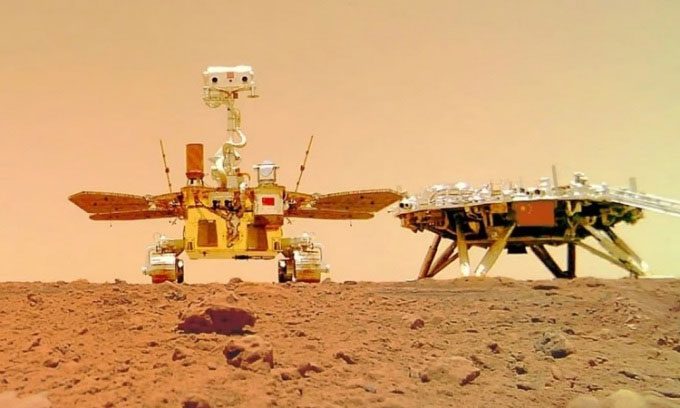Scientists are still waiting for a signal from China’s Mars rover after it awoke from hibernation last month, provided everything went according to plan.
Zhuri, powered by solar energy, entered sleep mode in May 2022 to wait out the cold winter and intense dust storms on Mars. Currently, the rover was expected to resume operations, but it has not yet sent any communication signals back to Earth, reported the South China Morning Post on January 6.

Zhuri has butterfly-shaped solar panels. (Photo: EFE).
The research team involved in the project is focused on understanding what happened. It is highly likely that dust storms have severely weakened Zhuri’s solar energy capabilities for electricity generation, according to a source in Chengdu, Sichuan. This source indicated that Chinese authorities plan to use the Tianwen-1 probe, which is currently orbiting Mars in an elliptical trajectory, to take photos of the rover. Zhuri is located in the southern region of the landing site, specifically in a large plain known as Utopia Planitia.
However, a source in Beijing reported that the ground control team is having difficulty downloading the latest data from the probe, which is equipped with two cameras. According to scientists’ predictions, Zhuri was expected to resume operations around December 26, 2022, when the northern hemisphere of Mars enters spring and environmental conditions improve.
According to Jia Yang, deputy director of the Tianwen-1 design system, the rover is designed to automatically wake up when two conditions are met: the power reaches 140 watts and the temperature of two key components, including the battery, exceeds -5 degrees Celsius. Scientists hope that after waking up, Zhuri will continue to head south and visit a site believed to be the location of an ancient ocean.
In May 2021, Zhuri and the Tianwen-1 lander successfully landed on Mars during China’s first independent mission to the Red Planet. Zhuri was designed with a lifespan of three months but has remained operational for a year, moving nearly 2 kilometers to survey the terrain. Using ground-penetrating radar, scientists found evidence of two major floods that occurred millions of years ago.
Zhuri is entirely dependent on solar energy. Its four butterfly-shaped solar panels are designed to resist dust accumulation. However, the rover still gets covered in dust during the most intense dust storms. “From a photo taken a few days after Zhuri landed in 2021, we can see that the solar panel was very clean. However, a photo taken in January this year reveals that the panels are covered in dust. It’s not hard to imagine that after the harsh dust storm season, Zhuri is now likely covered in Martian soil,” said an anonymous source in Chengdu.
The situation worsened when winter solar radiation also dropped to low levels, hindering the rover’s ability to generate power. Zhuri has completed all its required tasks. The China National Space Administration declared the Tianwen-1 Mars mission a success in June 2021. Besides Zhuri, two NASA rovers, Curiosity and Perseverance, are also operational on Mars.


















































